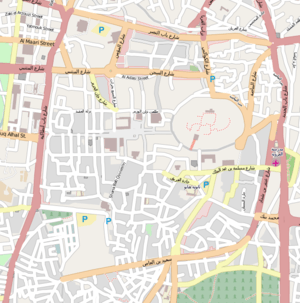Beit Junblatt
Beit Junblatt (Arabic: بيت جنبلاط) is a historic mansion in Aleppo, Syria, built in the 16th century by a Kurdish emir of the Jumblatt family.
| Beit Junblatt | |
|---|---|
بيت جنبلاط | |
 Beit Junblatt | |
 Location within Ancient City of Aleppo | |
| Alternative names | Qasr Junblatt |
| General information | |
| Type | Palace, Museum |
| Architectural style | Syrian |
| Location | Aleppo, Syria |
| Address | Al-Bandarah area, al-Farafira district Ancient Aleppo |
| Completed | 16th century |
| Cost | One thousand Ottoman gold lira |
| Client | Janpolad bek ibn Qasim |
| Technical details | |
| Floor count | 2 |
Background
Beit Junblatt (Arabic: بيت جنبلاط); originally Janpolad Palace (Arabic: قصر جان بولاد), is a historic mansion in Aleppo, Syria, built during the 2nd half of the 16th century by a Kurdish emir of the Jumblatt family, Jumblatt ibn Qasim.[1] In 1604–1605, it briefly served as a residence for the Ottoman wāli of Aleppo Hussein Pasha Janpolad.[2]
The mansion is located at al-Bandarah area of al-Farafira district, within the walls of the Ancient City of Aleppo.[3] According to the Aleppine historian sheikh Kamel al-Ghazzi, emir Janpolad spent 1,000 Ottoman gold lira to build the palace. Since 1766, the palace became the property of al-Kawakibi family. In 1814, it then served as the residence of the mufti of Aleppo sheikh Hasan Afandi al-Kawakibi.
Beit Junblatt is believed to have the largest iwan in Aleppo, decorated with fine qashani ceramic-tiled mosaic wall, depicting several Persian-type inscriptions.[4] Like the vast majority of Arabic traditional houses, the square-shaped courtyard of the palace has a large water fountain in the centre mainly used for wudu. It has been described as one of the most beautiful palaces built in the city.[5]
However, many associated external buildings around the palace—including a military barrack and stables—were said to have been ruined during the 1960s. It was subsequently restored by the Kuwait-Syria-Arab Fund to serve as a cultural centre and library.[6]
War damage
Beit Junblatt (Dar Janpolad) suffered material damage from fighting and looting during the Syrian civil war of 2012-16.[7][8] Numerous tiles were removed from the building's iwan allegedly to be shown as samples to international antiquities dealers.[9][10] Similar tiles were sold at a Western auction house in 2015.[11][2]
References
- Kurds in Lebanon
- Burns, Ross (2017). Aleppo: A History. New York: Routledge. pp. 229–231.
- Mansel, Philip (2016). Aleppo: The Rise and Fall of Syria's Great Merchant City. I.B.Tauris. p. 128.
- "موقع حلب - "قصر جنبلاط".. وأكبر إيوان في "حلب" Qasr Junblatt has the largest iwan in Aleppo". www.esyria.sy. Retrieved 2017-05-17.
- Darke, Diana (2006). Syria. Bradt Travel Guides. ISBN 9781841621623.
- Burns, Ross (2009-06-30). Monuments of Syria: A Guide. I.B.Tauris. p. 54.
- "In Photos: Damages of Dar Janpolad_Beit Junblatt in old Aleppo المديرية العامة للآثار والمتاحف". www.dgam.gov.sy. Retrieved 2017-05-17.
- Ross Burns (17 May 2017). "Monuments and sites reported damaged in the Syrian conflict since 2011".
- Shabi, Rachel (2015-07-03). "Looted in Syria – and sold in London: the British antiques shops dealing in artefacts smuggled by Isis". The Guardian. ISSN 0261-3077. Retrieved 2020-07-10.
- "Robert Fisk: Syria's ancient treasures pulverised". The Independent. 2012-08-05. Retrieved 2020-07-10.
- "Four 'dome of the rock' tiles | Olympia Auctions". www.olympiaauctions.com. Retrieved 2020-07-10.
External links
- "Bayt Junblat Aleppo, Syria". Archnet Digital Archive. Retrieved 20 March 2017.
- Stock images folder of Beit Jamblatt decorated with coloured and patterned tiles (2008)
- Image of the Iwan of Beit Jumblat in black and white
- No Strike List for Aleppo | Heritage for Peace
| Wikimedia Commons has media related to Beit Junblatt. |
Gallery
 Beit Junblatt Iwan (2001)
Beit Junblatt Iwan (2001) Beit Junblatt (2001)
Beit Junblatt (2001) Beit Junblatt (2001)
Beit Junblatt (2001) Beit Junblatt (2001)
Beit Junblatt (2001) Beit Junblatt (2001)
Beit Junblatt (2001) Beit Junblatt (2018) missing decorative elements
Beit Junblatt (2018) missing decorative elements Beit Junblatt Iwan (2018) Aleppo
Beit Junblatt Iwan (2018) Aleppo